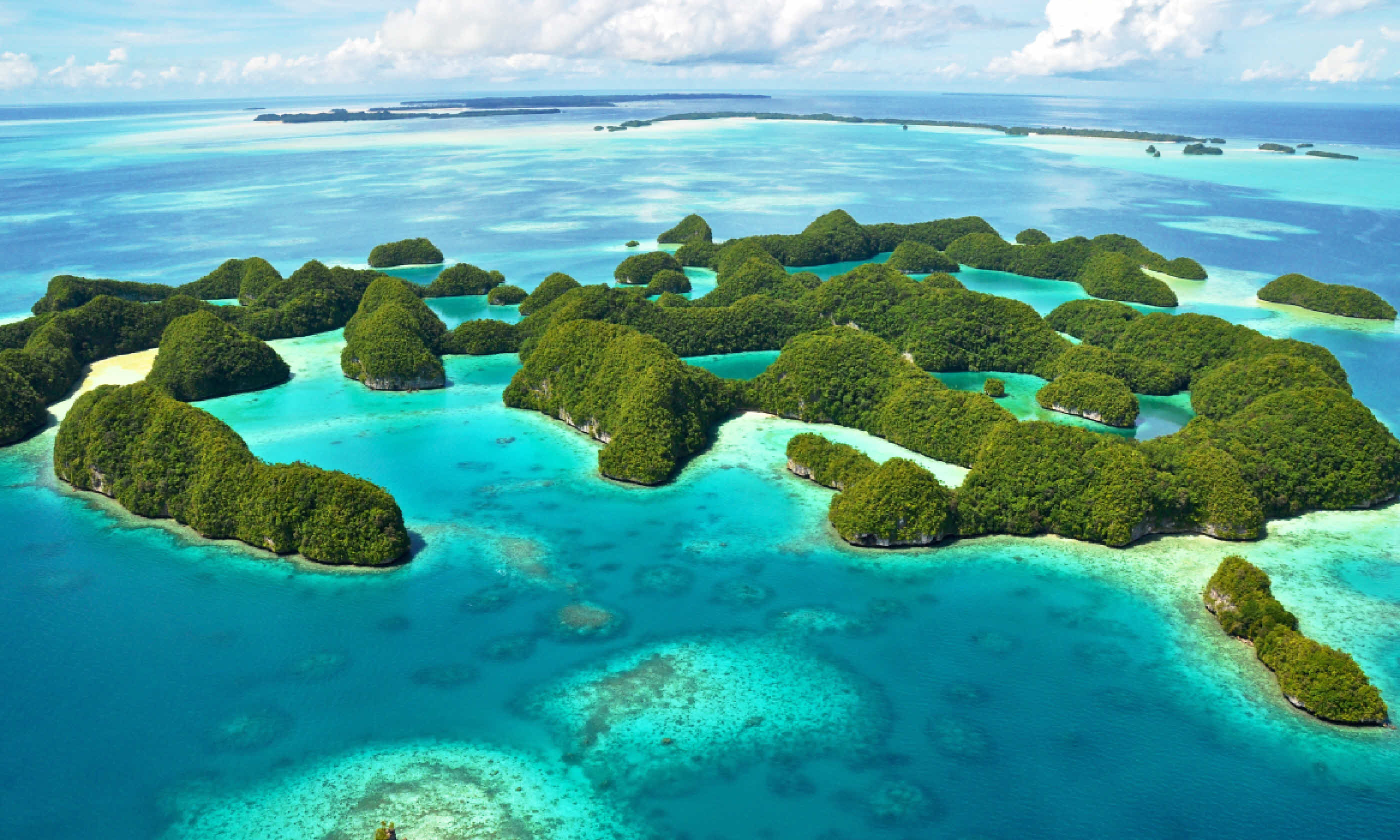
Exploring the paradise islands of Micronesia
Tropical good looks. Friendly locals. Fascinating history. Easy living. Far-spread and little-visited Micronesia is one of travel’s most postcard-perfect secrets
Propelled by the inky blue Pacific swell, our Zodiac burst through the atoll’s foaming barrier reef into a translucent bottle-green lagoon of tropical corals. It was then that I heard the singing.
Lamotrek’s islanders waited on a sandy beach under a coconut-palm canopy, singing and clapping rhythmically. Men in loincloths displayed tattoos lifted from the bible and the sea while bare-breasted women in homespun banana-fibre lava-lava sarongs shimmied considerable childbearing hips. Everybody was daubed with golden turmeric paste.
Wading ashore, I was garlanded with flowery
leis and soon shaking hands with seemingly all 320 islanders. Their welcome was as warm as the sky overhead. One elderly lady stooped to kiss my hand; a toddler stared with wide-eyed terror at the white devil emerging from the sea.
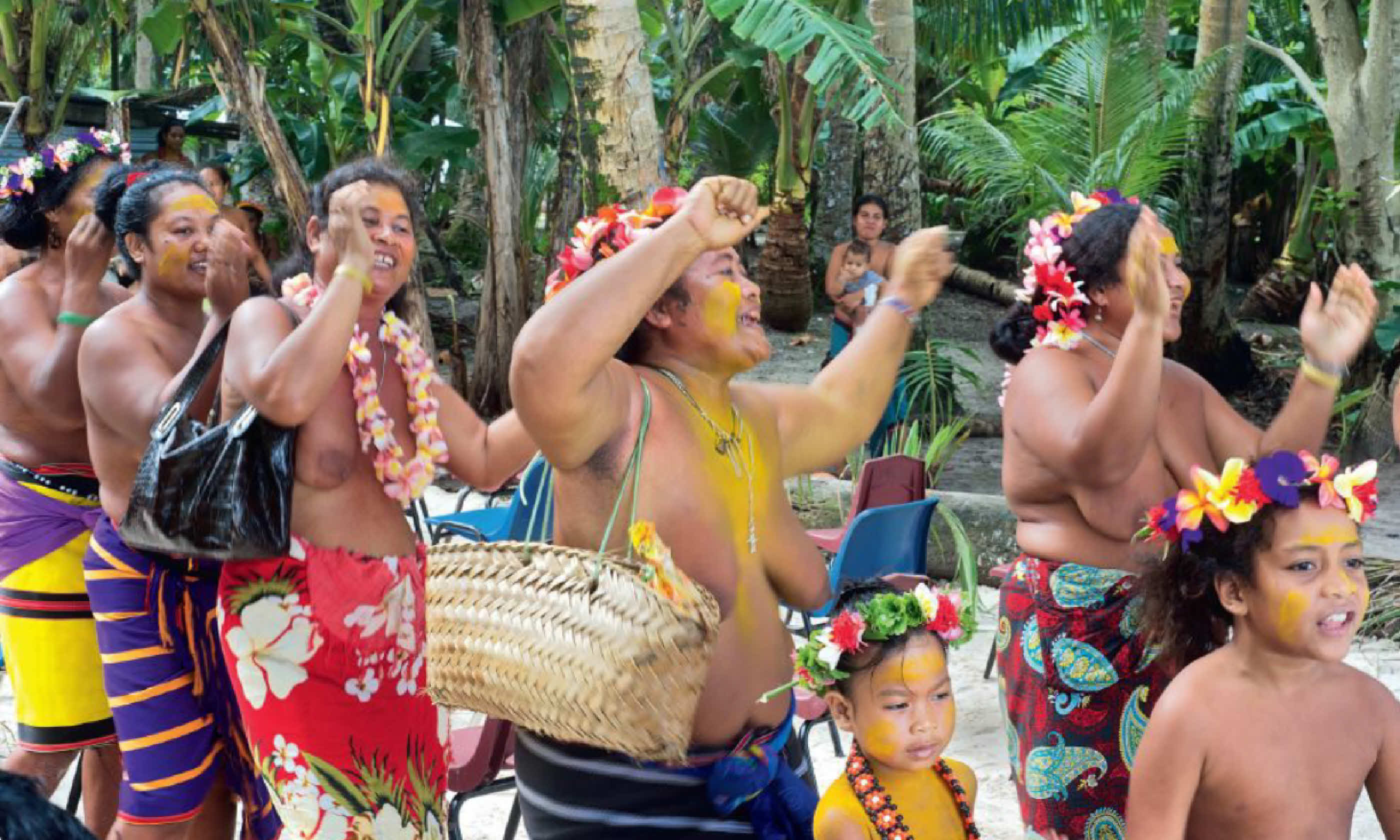 The islanders of Lamotrek (Mark Stratton)
The islanders of Lamotrek (Mark Stratton)
Lamotrek’s Catholic Deacon, Xavier, greeted us, saying they rarely encounter foreigners on this atoll, part of the Federated States of Micronesia. “Even our supply ship is four months late,” he lamented. “We’ve run out of sugar and cigarettes.”
Throughout the day the islanders demonstrated weaving and knotting fishing-nets; they ferried us across their lagoon on a single-hulled outrigger canoe, and I spotted a turtle amid the corals. Later, as islander Francis poured me sweet and intoxicating
falupwa (fresh coconut palm wine), he elaborated on their routine. “We tap falupwa every morning, then fish until afternoon. Then we drink and relax from 3pm until dinner and continue drinking after,” he explained. “But we don’t fish on Sundays – only church and drink.”
Terra obscura
The word ‘paradise’ is so overused these days it has almost become meaningless. Yet I wondered if I might have genuinely stumbled across its truest meaning in Micronesia? One of the least-visited frontiers on earth, Micronesia has a few tourist hotspots – such as Guam and Palau – but otherwise its remote islands, strewn across thousands of kilometres of the western North Pacific Ocean, remain extremely inaccessible.
Situated north of Papua New Guinea, Micronesia proper consists of Kiribati, several US dependencies (including Guam), Palau, the Marshall Islands, Nauru and the Federated States of Micronesia (or FSM). The latter’s 607 spartanly inhabited volcanic islands and coral atolls – including Lamotrek – span two longitudinal time zones.
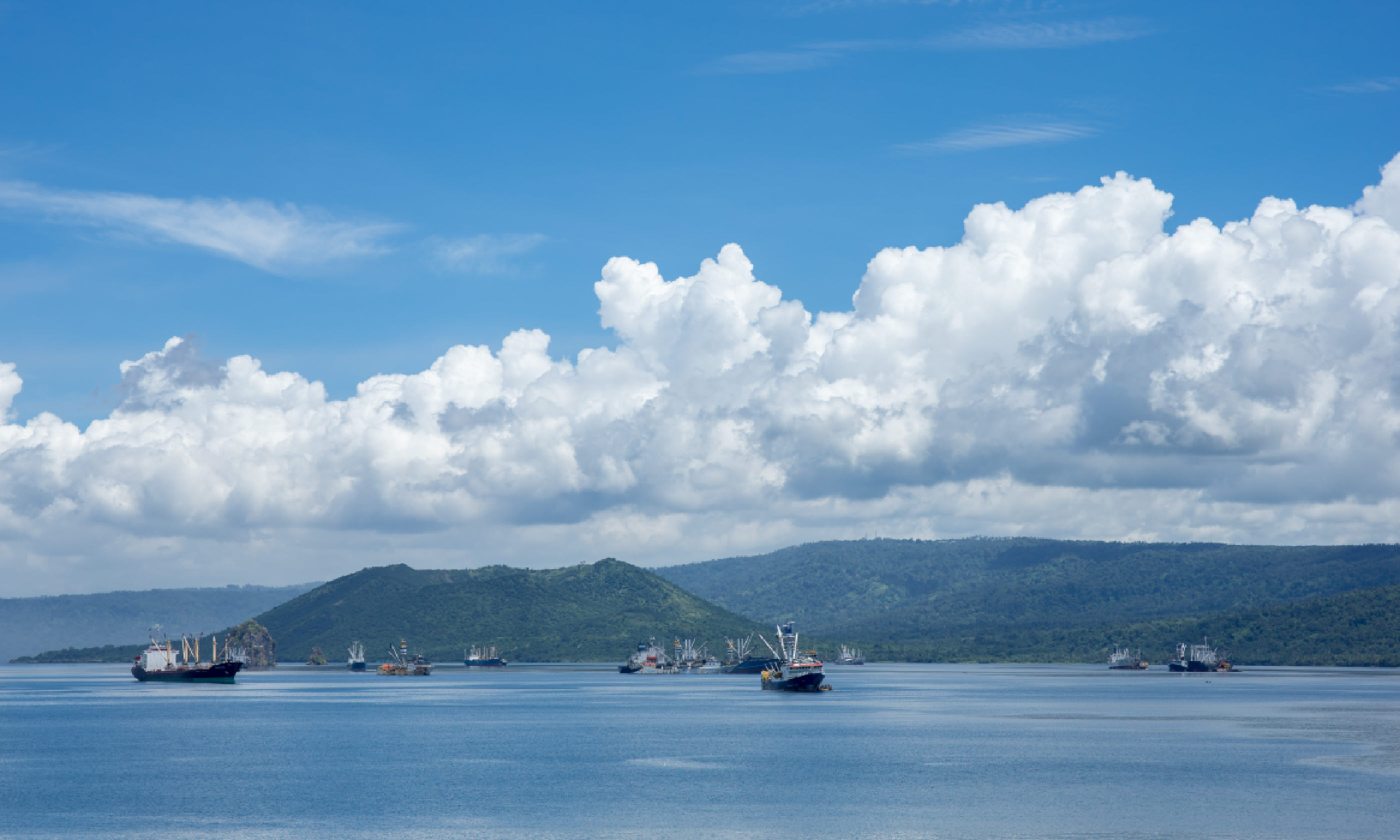 Mt Tuvuvur, Rabaul
Mt Tuvuvur, Rabaul
Originally settled several millennia ago by canoe migrations from Austronesia and South-East Asia, the FSM was purloined by the Spanish who sold it to Germany in 1899, before it was awarded to Japan in 1914. American post-WWII jurisdiction resulted in FSM becoming an independent federation of four archipelagic states (Yap, Chuuk, Pohnpei, Kosrae) in 1986. Ethnolinguistically, Micronesians are similar to Polynesians albeit possessing different customs.
I Googled ‘FSM’ before I went away. The top hit was the ‘Flying Spaghetti Monster’ – the noodly deity of comedy religion Pastafarianism. This reaffirmation of the federation’s obscurity only heightened my anticipation.
Melanesian beginnings
I’d long salivated about exploring Micronesia’s remotest atolls – to see if it lived up to its reputation, to meet its shrinking populations – yet my attempts foundered on the logistics of getting around by irregular cargo ships. My opportunity came courtesy of one of the few passenger ships exploring Micronesia, the
Silver Discoverer.
Flying to the Solomon Islands via Brisbane, I was greeted at the Honiara docks by a sleek, 103m-long expedition cruise ship. I joined 62 fellow passengers checking onto the luxurious vessel that would make the 17-day voyage across Micronesia to Palau. The ship’s Zodiacs would enable beach landings on the smallest atolls with an expedition team that included a dive master, marine biologist and historian, led by 44-year-old Bavarian geologist, Stefan Kredel.
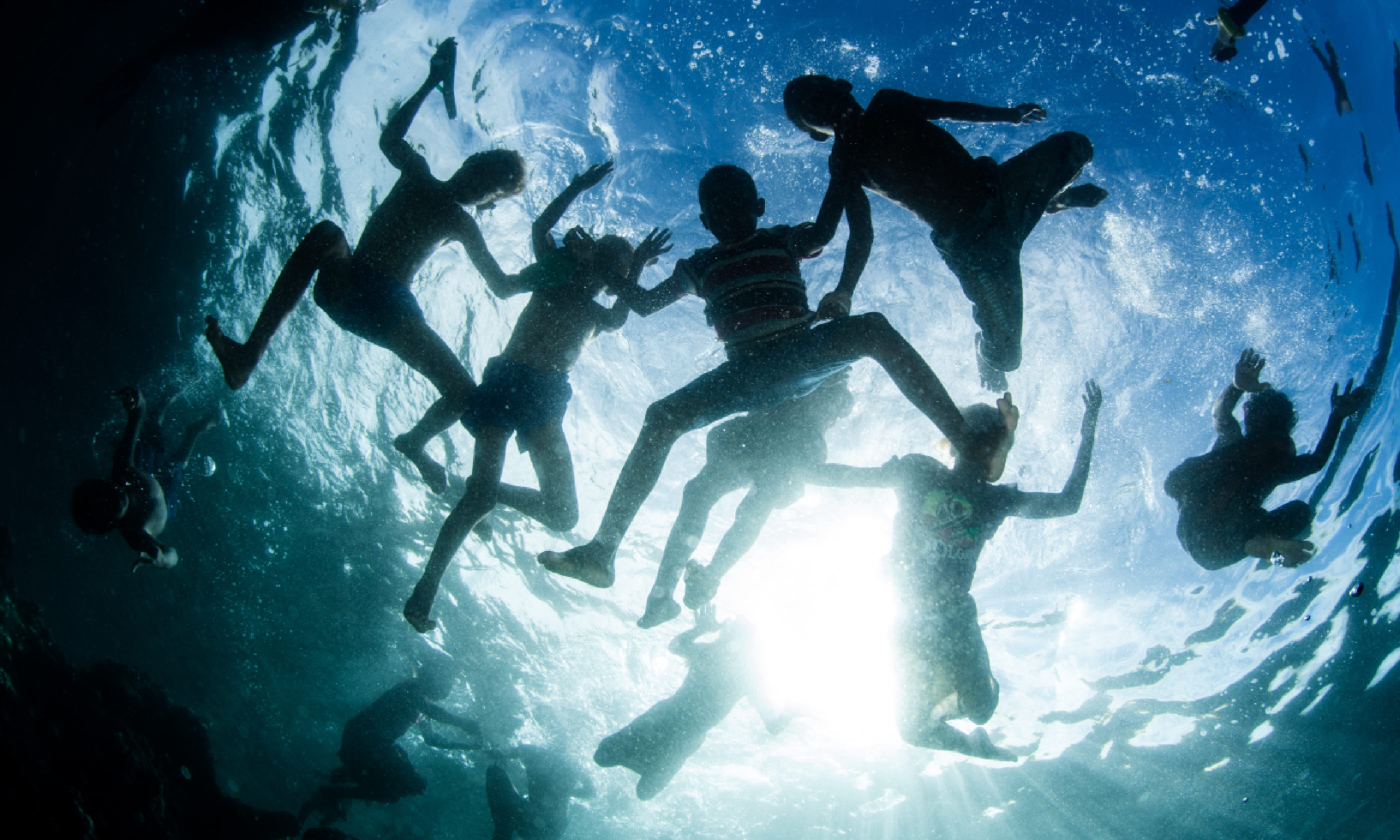 Children playing in the waters off the Solomon Islands
Children playing in the waters off the Solomon Islands
It would take us six days to reach Micronesia on our 5,900km voyage. Initially we sailed north-westwards through Melanesia along the Solomon Islands, stopping within the 700 sq km saltwater Marovo Lagoon, which is enclosed by a double barrier reef. Sheltered from the Pacific, the snorkelling inside Marovo at Lumalihe and Njari islands was sensational. I spent hours in 25°C seawater exploring coral gardens flush with clownfish, vivid starfish, pufferfish, giant clams and leopard-spotted sea cucumbers.
Our first port of call was Rabaul on the eastern side of New Britain island, some 60km off Papua New Guinea’s mainland. We docked in Simpson Harbour, part of a drowned caldera of an extinct supervolcano that has spawned a bayside arc of active cones; this includes menacing Mt Tavurvur, whose 1994 eruption obliterated Rabaul.
However, this evening’s pyrotechnics were provided by the local Bainang tribe’s fire dance ceremony to exorcise evil spirits. Frenetic young Bainang men wearing full-bodied masks of bug-eyed mosquitoes, butterflies and something approximating Donald Duck, trampled barefoot over a bonfire sending embers cascading into the dark. “They work themselves into a frenzy so do not feel the burning,” local guide Georgina told me.
In the morning, our vessel veered north into Micronesia crossing the equator into the Northern Hemisphere. Onboard distractions during our two long days at sea included pilates classes on deck, where I gazed at frigatebirds from contorted positions. Lectures ranged from fish identification to Micronesian culture. Especially interesting was Tua Pittman, a burly Cook Islander holding the honoured title of ‘Master Pwo Navigator’.
Micronesia is famed for navigators following the traditions of their forefathers by negotiating inter-island Pacific voyages using the stars. “We have to memorise maps of stars in both hemispheres. If it’s cloudy then we use the sun’s location or wave patterns,” he explained. It was under those stars that my days typically ended, sitting on the pool deck, eating tuna and plump prawns from the hot rock barbecue.
Land ahoy
After 44 hours at sea, Kapingamarangi – FSM’s southernmost outpost – appeared on the horizon. I’ve rarely seen such a striking seascape. Thirty-three wooded islets align around the barrier reef’s rim like an emerald necklace enclosing the 5km-wide mid-ocean lagoon. From satellite images the atoll is shaped like a teardrop; from the ocean, the islets optically bend with the curvature of the broad horizon.
The reef gap was too narrow for our ship to enter the lagoon so our Zodiacs zoomed towards two of Kapingamarangi’s four inhabited islands, Touhou and Welua. Around 500 Kapingamarangians live here, conversing in an endemic language closer to Polynesian than Micronesian. Customs official Wayne Hadley greeted us in shorts and flip-flops. He told us that they were waiting for a supply ship to arrive to export their copra, which is processed into coconut oil.
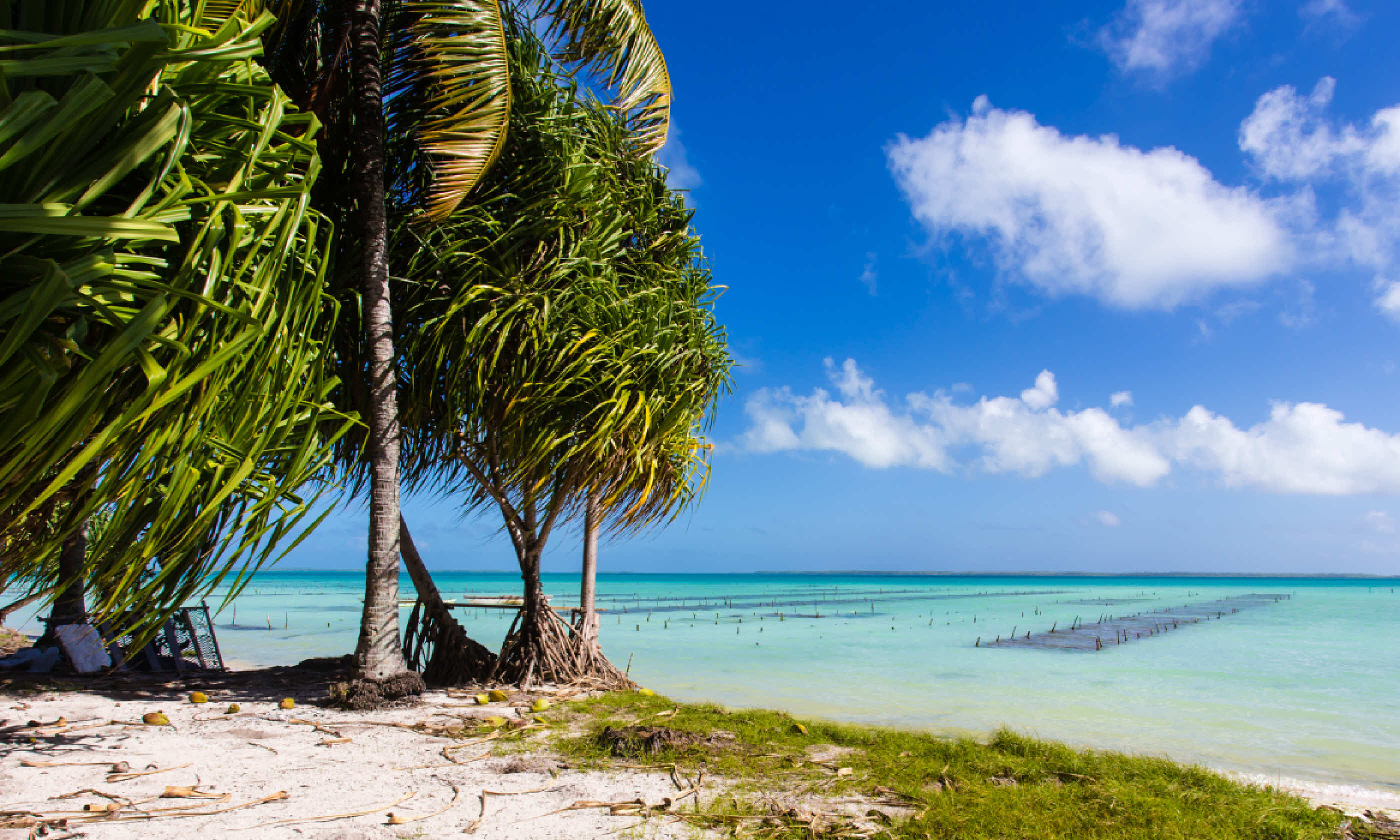 Republic of Kiribati (Shutterstock)
Republic of Kiribati (Shutterstock)
There is a formulaic simplicity to island life across these atolls. Palm-thatched huts raised on platforms nuzzle beaches with outrigger canoes primed for fishing. The sole brick building is typically a Catholic church.
The islanders’ self-sufficiency shines through: beneath the palms and breadfruit trees, Kapingamarangians grate coconut for oil, fry fish, pulp taro, tap wine and collect rainwater. They are so far removed from the outside world that when we left behind ice cubes, the children cradled them in their hands like precious diamonds.
Yet life does present some stresses. Given Kapingamarangi’s highest point is 90cm, the islanders often discuss sea-level rise – although their primary concern seems to be finding a spouse. “Everybody is related to each other,” Wayne moaned. “You have to find a distant cousin to marry.”
People problems
The issue exercising Mayor Senard Leopold on the atoll of Nukuoro, a further night’s sailing north, was depopulation. Only 200 islanders remain on Nukuoro – the smallest linguistic group in Micronesia. “Half our population is young children,” said Senard. “The children leave for Pohnpei [FSM’s island capital] to attend high school then maybe America for university. Once they experience Western life they don’t want to return.”
Bucking this trend is Ramon, Nukuoro’s chief prosecutor. I met him hanging up his morning tuna catch. Is there really much crime here, I asked. “None really,” he shrugged. “A couple of guys got drunk on palm wine a while back so I sent them home to sleep if off.”
He left Nukuoro for Pohnpei to further his work prospects but returned. “Pohnpei was expensive and stressful,” he said. “But life is paradise here, look around, everything you need to live is free.”
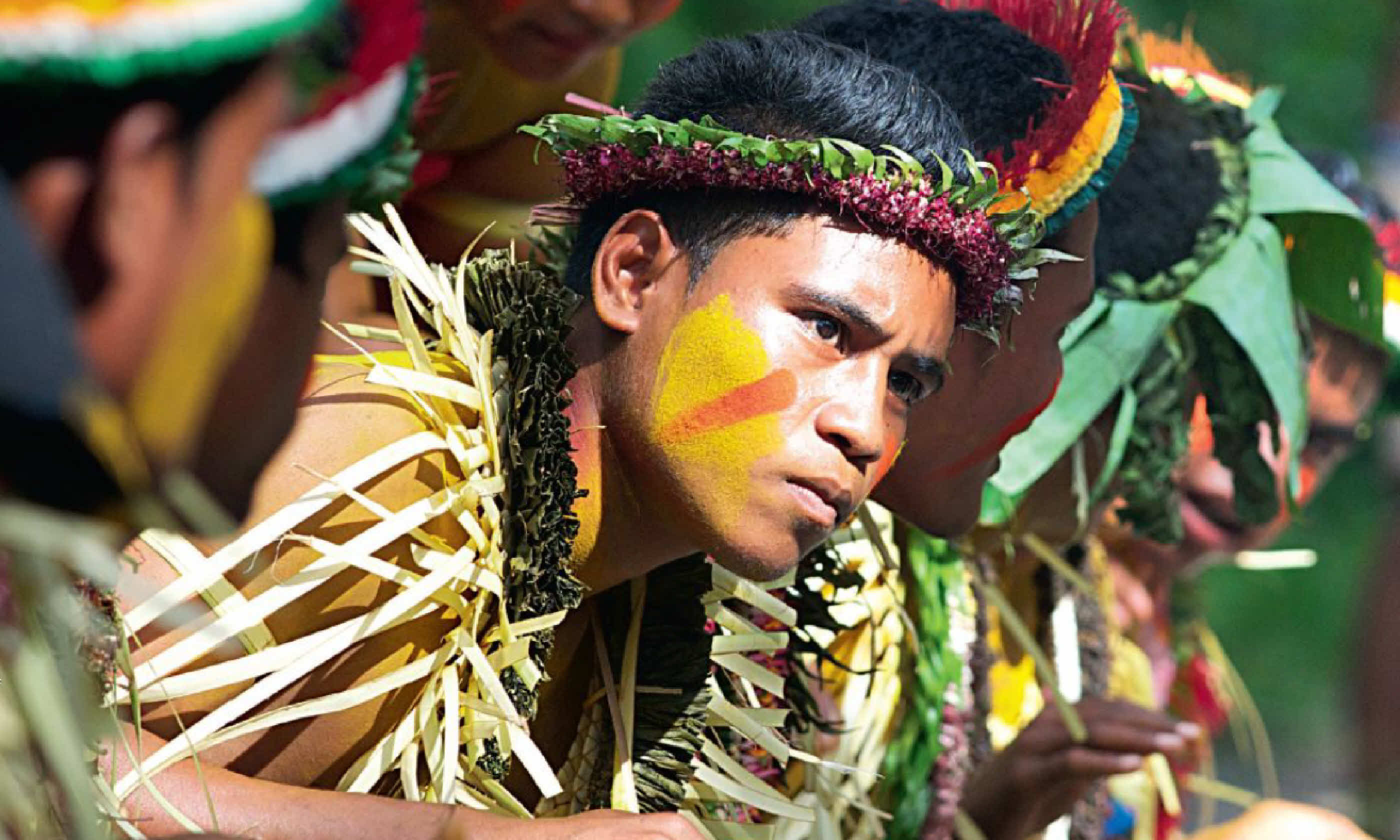 Celebrating Yap Day (Mark Stratton)
Celebrating Yap Day (Mark Stratton)
The next day, we steamed westwards along 7°N latitude, the start of a remarkable week of cultural and historical experiences, tracing the Caroline Islands. On Pohnpei we visited Nan Madol, Micronesia’s own Angkor Wat and the only ancient city built on a coral reef. Pohnpei is one of the world’s wettest places; accordingly, a torrential downpour was obscuring its black volcanic mountains.
“It pretty much rains always and then when you’re not expecting it,” said our Pohnpeian guide, Wilson, as we passed through the waterlogged, frangipani-fragrant jungle towards Nan Madol. Built between the 13th and 17th centuries by the seaworshipping Saudeleur dynasty, the site spans 92 artificially-made islets divided by Venetian-style waterways.
Each islet served different functions, including one for human sacrifices and another where priests fed sacred eels with turtle meat. During the Saudeleur-era, Pohnpei hosted 30,000 people, just shy of today’s population, but Nan Madol fell into disrepair after the dynasty was overthrown in 1628.
In hammering rain, I waded across a thigh-deep channel to the Royal Mortuary where Saudeleur kings once laid. The architecture is broodingly unusual: maroon hexagonal and polygonal columns of basalt lava skillfully stacked herringbone-style to fashion walls reaching 7.6m. Modern Pohnpeians consider this a place of maligned spirits because the Saudeleur were reputedly cruel; my own shivers were courtesy of rivulets of rainwater sliding down my back.
It was 30 years of Japanese rule, until 1945, that sent shivers down the Micronesians’ spines, dragging them into a terrible Pacific conflict with the US and Allied forces. The aftermath of this was evident two days later, when we entered Chuuk’s immense 2,129 sq km lagoon. Beneath the lagoon lies the wreckage of an extensive Japanese naval fleet, destroyed in February 1944 by the Americans during Operation Hailstone. Some 50 sunken vessels and 275 aircraft make for eerily spectacular snorkelling.
We swam to a zero fighter lying upside-down, ghostly pallid in the sediment. Then we snorkelled around a small Japanese naval patrol vessel, resting upright just below the surface; a ragged portside gash revealed its violent end, yet the vessel is undergoing a vibrant reincarnation as a coral reef, teeming with polyps and electric-blue damselfish.
Ships bells, sake flasks and brass diving-helmets are among the artefacts from the sunken fleet housed nearby inside Moen Island’s Kimio Aisek Museum. “The raid was payback by the Americans for Pearl Harbour,” the museum assistant explained.
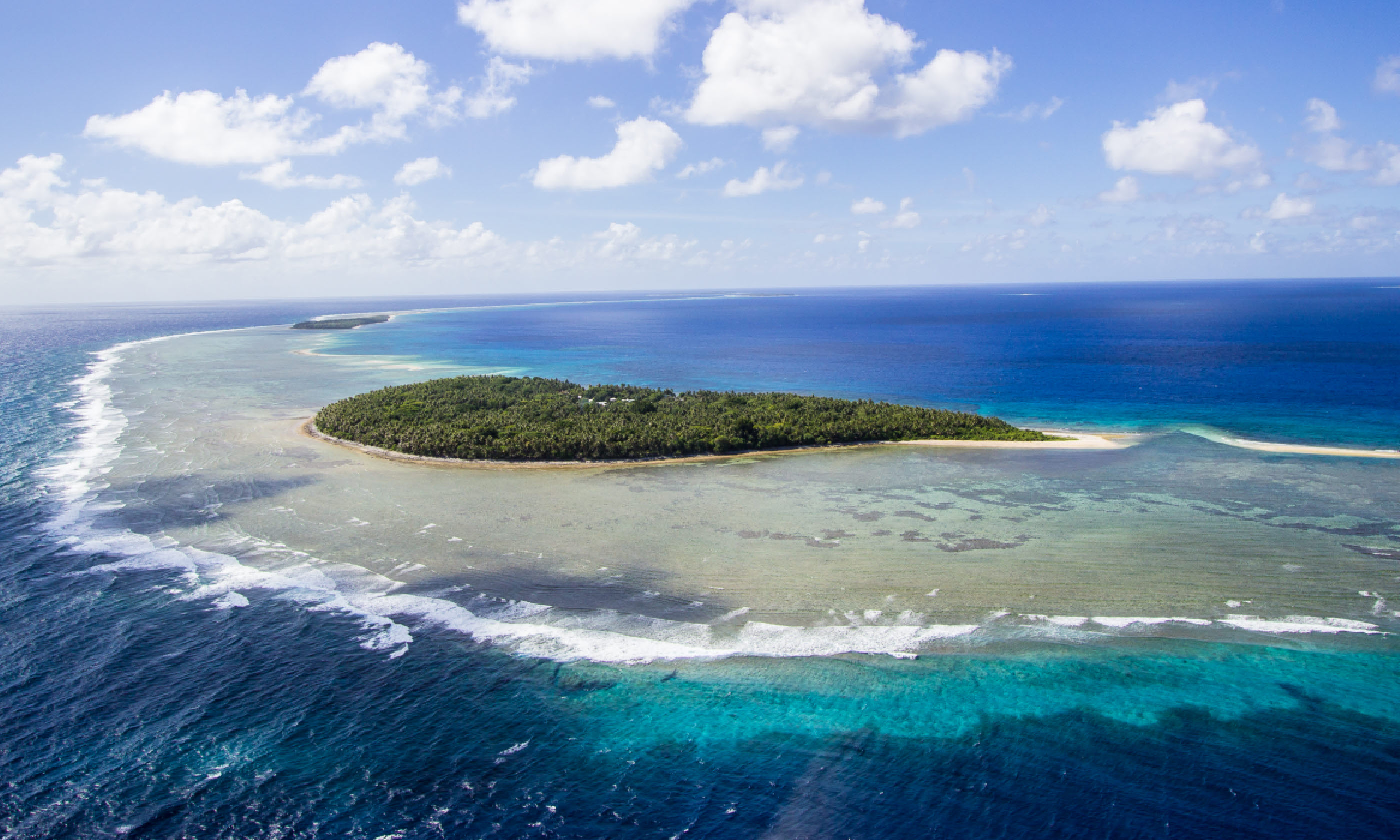 Yap State Micronesia (Shutterstock)
Yap State Micronesia (Shutterstock)
Yap State arrived further west along the Carolines, delivering two heart-warming cultural days on Lamotrek and Woleia atolls. After Lamotrek’s heartfelt welcome, we made a course adjustment to gatecrash Woleia’s annual cultural holiday: Yap Day.
We glided into Woleia’s millpond-calm lagoon around 7am. Around us traditional canoes ferried scattered populations from around the atoll to the main island, Falalop, for the festivities. Falalop’s beach was already crowded with picnicking families sharing banana leaf platters of pumpkin stew and susu taro, sweetened with coconut. The young men at sea demonstrated how to right sunken canoes while the dance performances sent the islanders crazy with whoops and catcalls. It was both joyous and suggestive.
The grass-skirted male dancers’ pelvic thrusting was a Chippendales reinterpretation of Morris dancing with the vigour of a haka. “You’re lucky to see this,” confided island elder, Martin Yangirelmar. “The youngsters want a more Western way of life and in future years our island may be deserted.”
Setting sun
The Micronesian traverse approached its end via Yap Island, where stone money is still used ceremonially for wedding dowries (the coins resemble millstones, some 5m-wide). We then pushed on to FSM’s most westerly outpost, the Ngulu atoll (population: eight), where I met George Mangthaw, who hadn’t left his tiny island since 1997. “There were 20 of us back then before the others left for Yap to drive cars, watch movies and eat chicken,” he complained.
We finally reached the western edge of Micronesia after arcing to 15°E. An independent archipelago of 586 islands, Palau offers the voyage’s most spellbinding scenery of wooded limestone pedestals rising like toadstools from a luminescent sea striped by multiple shades of blue.
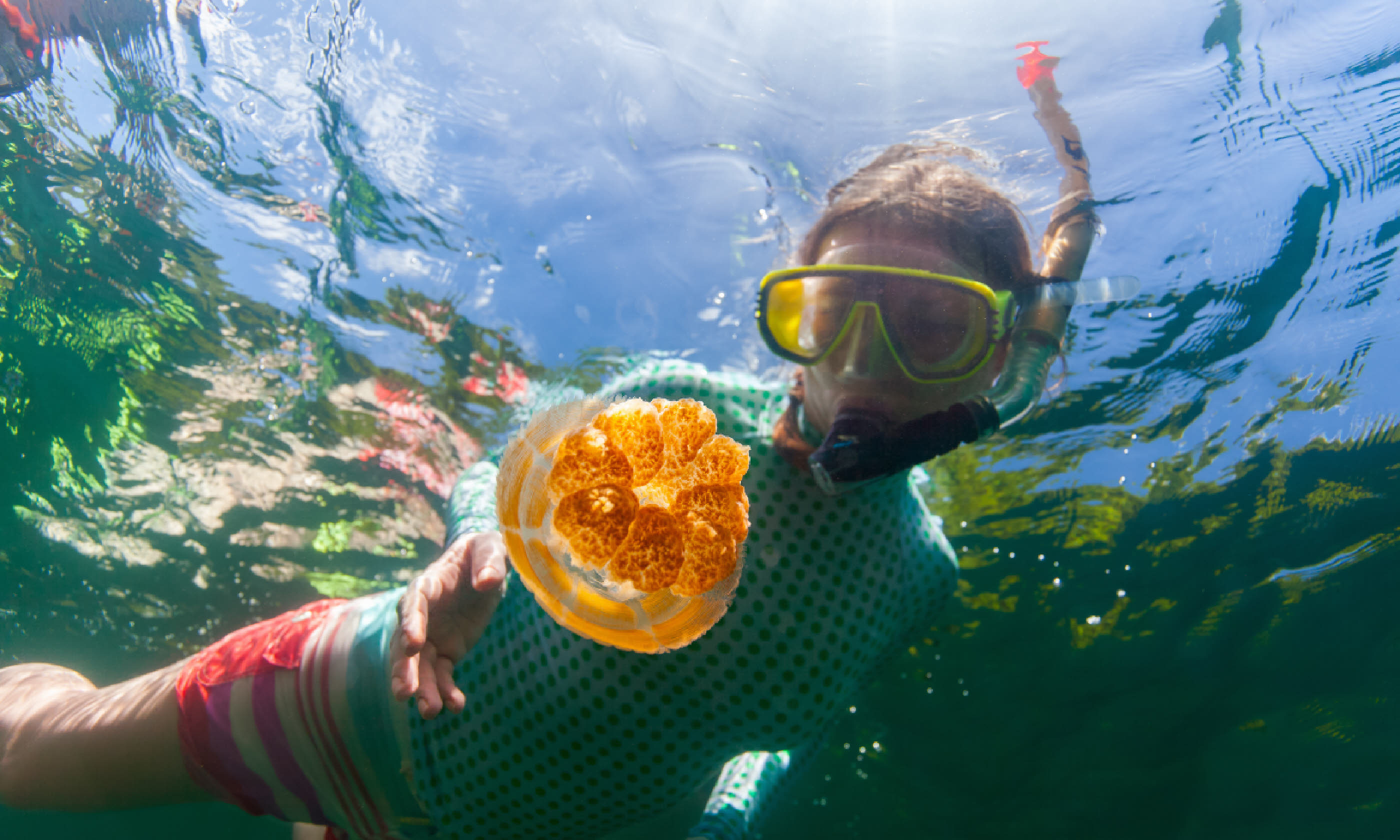 Snorkelling in Jellyfish Lake
Snorkelling in Jellyfish Lake
I joined a snorkelling trip to Palau’s UNESCO World Heritage-listed Rock Islands. After witnessing the finest diversity of tropical fish I’d ever seen at the ‘Big Drop’, I swam in Jellyfish Lake among eight million, dinner-plate-size yellowish-pink jellyfish.
The creatures have evolved in isolation with no predators so are sting-less. They bounced off my mask like dodgems; my feet unavoidably caressed their squidgy forms. Those above me floated surreally like UFOs, phantasmagorically lit by sunrays scything into the surface seawater. A typical technicolour day in, yes, I think I’m going to say it: paradise.
Make it happen...
The author travelled with
Silversea Cruises aboard the
Silver Discoverer. The 17-day Remote Cultures of The Coral Sea voyage from Honiara to Palau includes all meals, drinks and activities (including diving and snorkelling); international flights are not included. On Palau, snorkelling tours to Jellyfish Lake can be arranged with
Sam’s Tours.
The author flew with
Singapore Airlines to Brisbane, then onward to Honiara with
Solomon Airlines. On the return, he flew
United Airlines from Palau to Manila, then
Emirates via Dubai to London.







